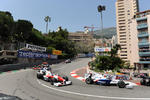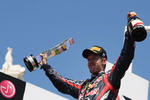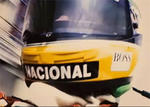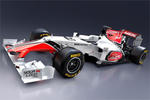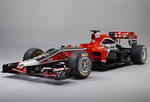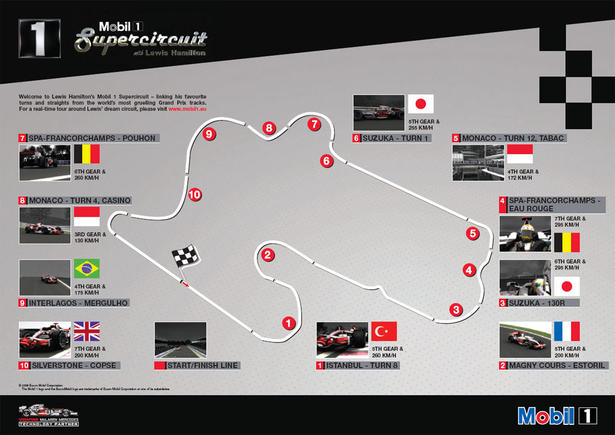
Mobil 1 announced today that it has presented F1 driver Lewis Hamilton with the opportunity to design his own F1 SuperCircuit. Lewis Hamilton's F1 SuperCircuit fantasy race track features all his favorite corners, chicanes and straights from the circuits around the world. Lewis Hamilton's F1 SuperCircuit is counter-clockwise and includes corners from Monaco, Interlagos, Silverstone and Spa-Francorchamps.
Follow the jump for the full list of corners featured by Lewis Hamilton's F1 SuperCircuit.
Mobil 1 Press Release:
To round-off Lewis Hamilton’s glorious winning season, the Vodafone McLaren Mercedes’ Technology Partner, ExxonMobil, presented him a final challenge: to design the ultimate ‘Supercircuit’.
This fantasy race track is a combination of the toughest corners, chicanes and straights from Hamilton’s favourite circuits around the world. It is also a fascinating insight into where
adrenaline levels are at their highest, and the levels of performance that are required by the car, engine and race lubricant.
Hamilton planned a counter-clockwise circuit to be the definitive challenge – of both a driver’s skills and a car’s technological performance and stamina. Corners from Monaco, Interlagos, Silverstone and Spa-Francorchamps were slotted together to build his very own dream track: Lewis Hamilton’s Mobil 1 Supercircuit.
Lewis explained “I wanted to create a circuit that would be challenging, exhilarating and
enjoyable, but most of all somewhere you would love to have the chance to drive and provide the definitive test for any driver, in any car.”
Lewis' Supercircuit starts on the home straight. As Hamilton waits for the red lights to go out, his heart rate climbs to 170bpm in anticipation of the start, for this is going to be no ordinary lap. Suddenly the lights go out; Lewis releases the clutch to let loose in excess of 750bhp through the rear wheels of his Vodafone McLaren Mercedes MP4-23. He accelerates towards Turn 1…
1. Turn 8, Istanbul Speed Park (5th gear, 260 kph, 5g)
A super-fast corner to begin the lap. Lewis withstands up to 5g for six seconds through this quadruple-apex left-hander, making it the longest and most physical corner on the Grand Prix calendar. The prolonged lateral loads place the engine’s 300 moving parts under enormous stress and make it staggeringly tough on Lewis’s neck muscles. “You have to attack this corner,” says Lewis. “A bump at the first apex destabilises the car and you have to be very careful with how you position it, otherwise you can have a big oversteer moment.”
2. Estoril, Magny Cours (5th gear, 200 kph, 3.5g)
Lewis’s neck gets little respite because Estoril, another long and fast corner, comes next. It’s a double-apex right-hander, through which Lewis has to plant the throttle in fifth gear without being able to see his exit. The track undulates through 180 degrees, leaving him on a high-speed rollercoaster. “Due to the high speeds,” he says, “the car generates a lot of downforce through this corner and it feels planted to the track. It’s great fun, but it’s vital to make a good exit because a long straight follows.”
3. 130R, Suzuka (6th gear, 295 kph, 4g)
Lewis will have to wait until 2009 to drive a his Grand Prix race car at Suzuka for the first time, but such is the track’s fearsome reputation that he has included two corners from the former Japanese Grand Prix venue on his Mobil 1 Superlap. 130R is a left-hander, so-called because it has a radius of 130 metres, and it’s taken flat-in-top-gear with the engine screaming at its 19,000rpm limit. Lewis turns in smoothly and lets the car run wide over the smooth exit kerb to ensure that he scrubs off as little speed as possible.
4. Eau Rouge, Spa-Francorchamps (7th gear, 295 kph, 3.5g)
Like 130R, Eau Rouge is a section that’s taken flat-out. The corner is in fact three bends, a left-right-left flick up the side of a hill, and it sees Lewis experience lateral and vertical g-forces. “This is one of the best corners on the calendar,” says Lewis. “It’s not difficult, but you’re just excited all the way through it. As you climb up the side of the hill, there’s a moment when all you can see from the cockpit is the sky. It’s fantastic because you lose your stomach over the crest at the top.” The car loses a bit of speed as it climbs the hill, but the whole section still takes only one second to complete at 305kph.
5. Tabac, Monaco (4th gear, 172 kph, 2.5g)
After a long period on full throttle, Lewis needs to be careful not to out-brake himself on this slippery section of street circuit. Tabac is the slowest corner on the lap, through which the Mobil 1 oil inside Lewis’s Mercedes V8 engine travels faster than the car. “At the Monaco Grand Prix we have maximum downforce,” says Lewis, “so the car feels planted to the ground. But with the barriers so close there is no room for error; you have to be very precise.” Some slippery white lines at the exit can induce oversteer as Lewis tries to get back on the power, making it a great test of driver skill.
6. Turn 1, Suzuka (5th gear entry, 255 kph, 3.5g)
The car accelerates quickly along the downhill run towards Suzuka’s Turn 1. Lewis is into seventh gear when he turns into this double-apex right, through which he has to turn, brake and change down three gears before hitting the first apex. Without changing his steering lock, Lewis hustles the car to the second apex, where he gets back on the power and accelerates uphill towards the exit kerb.
7. Pouhon, Spa-Francorchamps (6th gear, 260 kph, 4.5g)
The second of Spa-Francorchamps’ entries on the Mobil 1 Superlap. Like Suzuka’s Turn 1, Pouhon has a downhill approach, but Lewis doesn’t touch the brakes before he turns into this double-apex left. He has a small confidence lift, changes down one gear and then gets back on the power as soon as possible. “You have to carry as much speed through the corner as possible,” says Lewis, “and that means having the guts to get back on the power as soon as possible. You have to be careful because you can’t touch the kerbs.”
8. Casino Square, Monaco (3rd gear, 130 kph, 2.5g)
The Casino is the most famous landmark in Monaco. The cars pass to the left of its revolving doors as they enter Casino Square, where they are faced with a blind and bumpy right-hander. Lewis slows his car to just over 160kph and positions it in the
middle of the track for the entry. “I really enjoy driving through here,” he says, “because one corner leads to another. There is not rest for the driver.” As soon as he hits the apex kerb he’s back on the power, but he needs to be wary of two bumps at the exit, which induce wheelspin and make it difficult to feed in the power of his Mercedes-Benz V8.
9. Mergulho, Interlagos (4th gear, 175 kph, 3g)
It was here, on the final lap of the 2008 Brazilian Grand Prix, that Lewis prepared to pass Timo Glock for fifth place and claim his maiden world title. But that’s not why he’s included it on his Mobil 1 Superlap. “This is a very bumpy left-hander,” says Lewis. “It slopes downhill and you can carry more speed than you initially think is possible because a compression in the middle of the corner helps to turn the car. You’re really on the limit and you need amazing car control to keep a hold of it.” A clean exit is vital because Lewis carries that speed all the way to Copse, the final corner on the lap.
10. Copse, Silverstone (7th gear, 290 kph, 4.5g)
This is one of the fastest Grand Prix corners and it grabs Lewis’s attention in more ways than one. He approaches it in seventh gear and literally throws the car towards the apex barrier. Yes, a barrier separates the pitlane and the track at this point, which makes the 273kp/h corner completely blind. “You can’t touch the brakes,” says Lewis. “You have to turn in with a small lift and just hope you get round.” The direction of the wind influences car performance through here because a head wind generates more aerodynamic downforce than a tail wind. “If the conditions are right,” continues Lewis, “you can take Copse without a lift, but that’s pretty scary.”
Lewis then lets his MP4-23 run onto the flat exit kerb and powers his way across the start-finish line to begin another lap. He’s clearly having the time of his life.
To explore Lewis’s Mobil 1 Supercircuit go to: www.mobil.co.uk
Mobil 1 Supercircuit: a look under the hood
Start line
As the engine is fired up and revolutions increase, the temperature of the oil rises rapidly – the oil has reached its normal operating temperature after approximately 30 seconds after leaving the garage and well before Lewis starts his flying lap. From the start of engine fire up the lubricant’s job is to remove the heat from the moving parts, dissipating approximately 30% of the heat generated.
Istanbul - Turn 8
As Lewis accelerates up through the gears the engine would reach the maximum speed of 19,000 rpm at the first corner. The Mobil 1 oil would be working hard to protect and cool the engine’s 300+ moving parts, pulsing 500 times faster than Lewis Hamilton’s heart rate.
Magny-Cours - Estoril
Following his exit from Istanbul’s turn 8, Hamilton would then head straight into the Estoril corner before enjoying a straight and then heading into a complicated combination of three demanding corners.
Suzuka – 130R
Included despite Lewis never having raced this circuit in a Grand Prix car – highlighting the significance of this corner in the world of motor racing – this corner is approached flat out down the back straight with barely any lift or brake, placing the engine under increased strain as the pressure builds.
Spa-Francorchamps – Eau Rouge
The combination of exiting the Suzuka 130R and heading into the Eau Rouge segment of the lap, where the car would enter into a period of wide open throttle, would see the Mobil 1 lubricant subjected to forces equivalent to four Mercedes cars pressing down on an area smaller than a fingerprint.
Monaco – Turn 12, Tabac
One of the slower turns, the unforgiving nature of Tabac – with no run-off – sees drivers risk shaving the barrier to set a quick time. As the corner requires Hamilton to dramatically reduce his speed down to less than 160kph, the Mobil 1 oil in the engine would actually be travelling faster than the speed of the car.
Suzuka – Turn 1
One of the toughest corners on the Supercircuit, Turn 1 at Suzuka is approached flat out from a long straight maximum speed around 321kph – with the car working flat out to keep up with the test of the driver’s temperament and nerve.
Spa Francorchamps – Pouhon
Unlike Tabac, Pouhon is a corner where you can’t touch the kerb. As you carry as much speed as possible into the corner you have to get on the power as soon as you can, forcing the car to combine the stress of turning with acceleration. The Mobilith SHC synthetic grease in the wheel bearings and drive shaft tripod joints minimizes rolling resistance, this helps Lewis to carry as much speed as possible through the very fast Pouhon corner which is taken in 6th gear at 260 kph".
Monaco – Casino
This is a corner that has formed part of a great success story for the Vodafone McLaren Mercedes team over the years – with the team producing more winners at Monaco than any other constructor.
Interlagos – Mergulho
After Casino, the Supercircuit heads into Mergulho, one of the last major corners of the Interlagos circuit in Brazil, a point when Hamilton would really be pushing it to the edge: “As the penultimate turn of my Supercircuit, Mergulho provides such a test for both your body and the car – as you need to combine patience with concentration to really exit and push forward at speed towards Copse.”
Silverstone - Copse
At Copse corner, the car would be at top speed ahead of a hairpin immediately before the final straight. Here a film of synthetic oil in the gearbox approximately eighty times thinner than a human hair must keep the surfaces of the gears apart under the tremendous loads.


